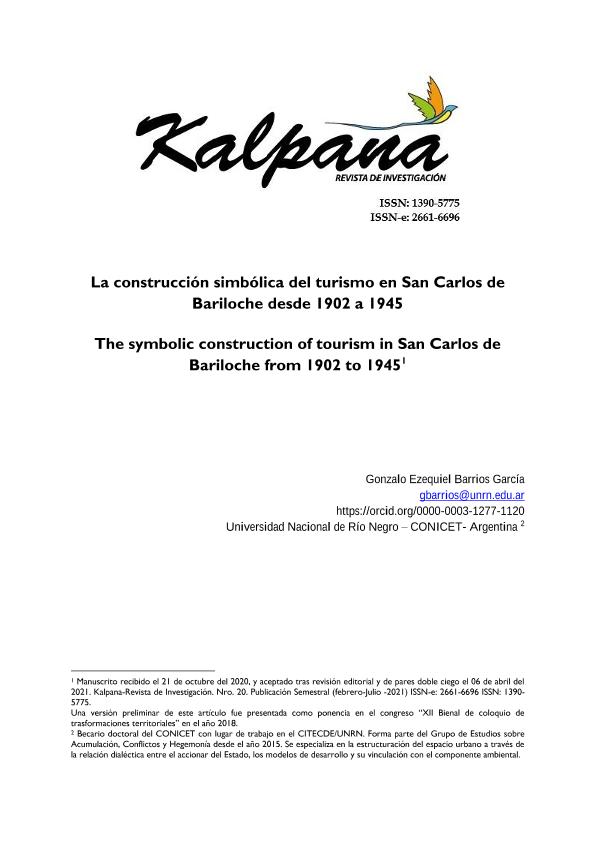Artículo
La ciudad de San Carlos de Bariloche, en la provincia de Río Negro, Argentina, ha sido caracterizada como un destino eminentemente turístico por gran parte de la bibliografía académica y documentos públicos, se destaca la figura de Ezequiel Bustillo al frente de la Dirección de Parques Nacionales como el principal o incluso el único promotor de este proyecto de ciudad. Desde la perspectiva de la historia cultural urbana y por medio de análisis de diversas fuentes documentales desde 1902 a 1945, testimonios de época de A.M. Elflein, E. Morales, A. de Anchorena, F. P. Moreno y B. Willis; el presente trabajo tiene por objetivo matizar y contextualizar algunos elementos que se adjudican al proyecto propuesto por Bustillo que impulsó a la localidad de S. C. de Bariloche como un destino eminentemente turístico y europeizado. Como resultado constatamos la presencia de una determinada manera de caracterizar la localidad desde inicios del siglo XX, que se enfoca casi exclusivamente en la similitud del paisaje con el imaginario suizo y delimita el desarrollo económico local a uno ligado exclusivamente con el turismo. En este sentido, podemos concluir que en las prácticas materiales desplegadas por Bustillo se conjugaron con un proceso histórico, cultural y social de largo recorrido, e influyeron decisivamente en la construcción simbólica del paisaje y la ciudad como destino turístico. San Carlos de Bariloche is usually characterized as a tourist destination by a variety of public documents and academic articles. The figure of Ezequiel Bustillo as the head of the National Parks Directorate was highlighted as the main or even the only promoter of this city project. Taking urban cultural history as a framework, and the analysis of various documentary sources from 1902 to 1945 and testimonies written by A.M. Elflein, E. Morales, A. de Anchorena, F.P. Moreno and B. Willis, the present work aims to clarify and contextualize some elements that are awarded to the project proposed by E. Bustillo that promoted the town of SC de Bariloche as an eminently tourist and European looking destination. As a result, we verify the presence of a certain way of characterization of the town since the beginning of the 20th century, those books and articles explored the similarities of the landscape between SC de Bariloche with the Swiss; and delimits local economic growing to one linked exclusively to tourism. We conclude that the ideas of E. Bustillo were combined with a long-term historical, cultural and social process and decisively influenced the symbolic construction of the landscape and the city as a tourist destination.
La construcción simbólica del turismo en San Carlos de Bariloche desde 1902 a 1945
Título:
The symbolic construction of tourism in San Carlos de Bariloche from 1902 to 1945
Fecha de publicación:
07/2021
Editorial:
Universidad de Especialidades Turísticas
Revista:
Kalpana
ISSN:
1390-5775
e-ISSN:
2661-6696
Idioma:
Español
Tipo de recurso:
Artículo publicado
Clasificación temática:
Resumen
Palabras clave:
BARILOCHE
,
PARQUES NACIONALES
,
TURISMO
,
PAISAJE
,
CONSTRUCCIÓN SIMBÓLICA
Archivos asociados
Licencia
Identificadores
Colecciones
Articulos(CCT - PATAGONIA NORTE)
Articulos de CTRO.CIENTIFICO TECNOL.CONICET - PATAGONIA NORTE
Articulos de CTRO.CIENTIFICO TECNOL.CONICET - PATAGONIA NORTE
Citación
Barrios Garcia Moar, Gonzalo Ezequiel; La construcción simbólica del turismo en San Carlos de Bariloche desde 1902 a 1945; Universidad de Especialidades Turísticas; Kalpana; 20; 7-2021; 7-29
Compartir




